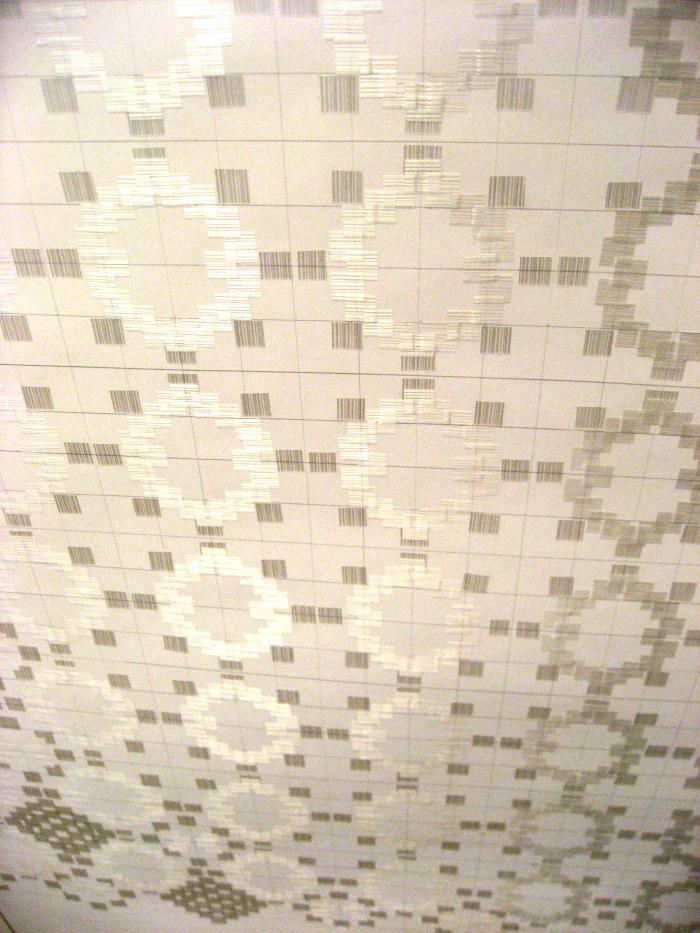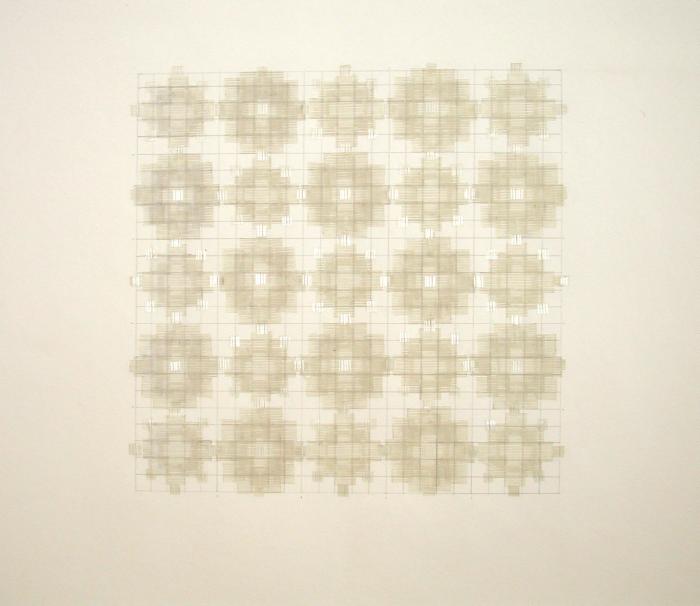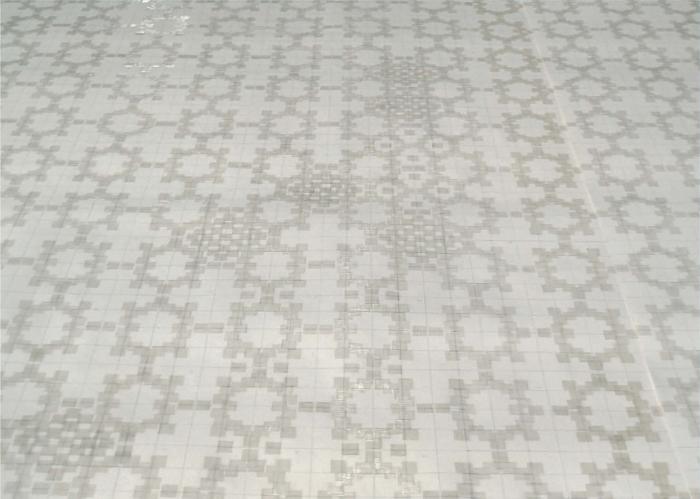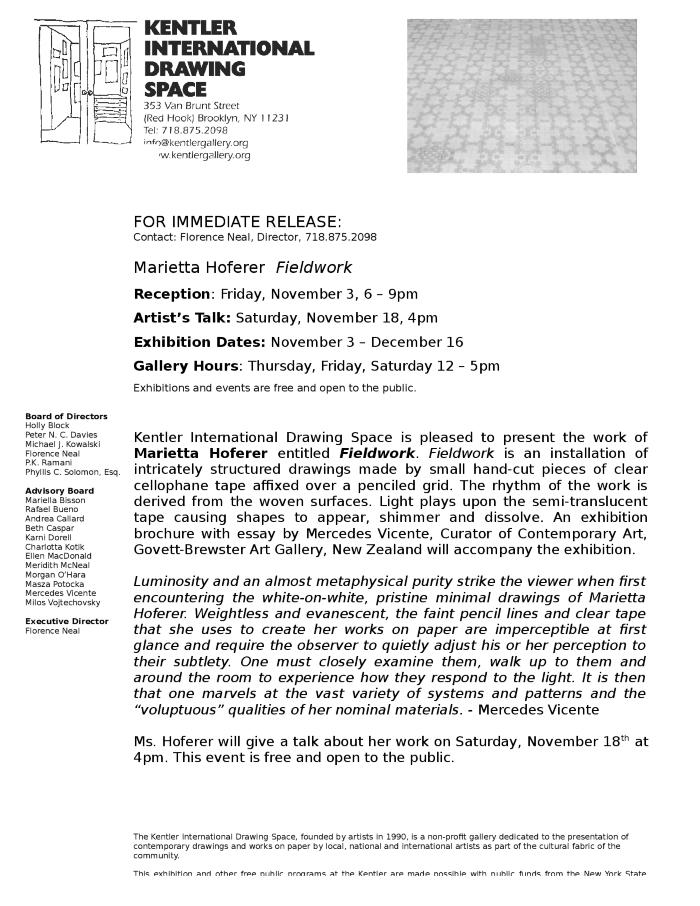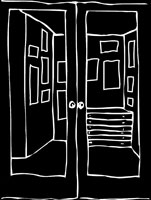exhibition
Marietta Hoferer, Fieldwork
Date
November 3 – December 16, 2006Opening Reception
November 3, 2006Artist
Marietta Hofererexhibition Images
Click to Enlarge.
Press and Promotion
About the exhibition
Luminosity and an almost metaphysical purity strike the viewer when first encountering the white–on-white, pristine minimal drawings of Marietta Hoferer. Weightless and evanescent, the faint pencil lines and clear tape that she uses to create her works on paper are imperceptible at first glance and require the observer to quietly adjust his or her perception to their subtlety. One must closely examine them, walk up to them and around the room to experience how they respond to the light. It is then that one marvels at the vast variety of systems and patterns and the "voluptuous" qualities of her nominal materials. Lucidity, analysis and logic are attributes that characterize this German-born, New York-based artist. Her systematic approach to drawing, employing a concise structural framework, determines how the work is formatted prior to its execution. Yet in Hoferer's devotion to precision and exactitude, an impulse for the vague and the wandering emerges. Her predilection for the grid, symmetry and seriality dealing with concepts of limit and measurement inevitably finds its dichotomy, revealing infinitude and entropy. Behind the severity imposed by the rigorous definition of the drawings' structure and deliberate execution, lies a hedonism that relaxes these restrictions and allows for the occurrence of chance, movement and mutability, uncertainty and the undefined in the process. Unlike the orthodoxy of the minimalist fathers such as Sol LeWitt, Hoferer imparts a relaxed eclecticism in her drawing that allows for detours and departures from the severe approach of the earlier generation. Beneath the apparent crispness and stark order, there is an entropic sensibility. Hoferer welcomes contingencies and internalizes chance in the making of the work. Playfulness and sensuality soften the severity of the cooler, rational sensibility with ingenious games and unexpected disruptions to the operational logic of the work and the formal qualities of her materials. The industrial tape and the hand-drawn graphite lines are foils for one another, which creates cunning paradoxes. The hard line of the tape may be undermined by its stretchiness and only approximate applied rows; while pencil lines, though imprinted with the natural variations produced by the hand (pressure, speed, stops and starts, tiredness), may achieve exactitude when drawn with a ruler. Hoferer enjoys exploring and contesting these dichotomies. Challenging the very systems that she imposes on her drawings as if "the one that creates the rule creates the tramp," she deliberately introduces disruptions that have less to do with her lack of endurance to carry out the self-imposed tasks than with the intellectual quest of solving how to break out of them. This liberating effect catches the viewer off guard, inciting a closer look to discover the drawing's internal logic.Whereas LeWitt's radical approach had reduced drawing to a set of instructions no longer requiring the execution by the artist but by anyone simply following the instructions, Hoferer does make the drawings herself. Draftsmanship (or craftsmanship) is here clearly intended, not for reasons of originality as much as to allow for the potential of chance and to emphasize the idea of process in the making of the drawings. Process and the parameters of the physical condition of the piece determine its eventual form. As in Dorothea Rockburne's seminal 1960s series titled Drawing Which Makes Itself, Hoferer's drawing is generated from the qualities inherent in the materials. She chooses materials for their physical properties such as luminosity, translucency and invisibility, reflectivity, glossiness, mattness and frosted texture, or because they age and discolor over time, as in this series, Field (1998-2006). Her choice of white only proves to offer unconstrained variations of "whiteness," following in the footsteps of monochrome painters, most obviously Robert Ryman. She uses a great variety of tapes -Scotch brand, strapping and masking– that change in size and texture, translucency and reflectivity. In applying the tape in vertical and/or horizontal bands and multiple layers, an interplay of shadow and light is achieved, with incredible shades of white and gray and dynamic optical shifts--glittering and shimmering, surfacing or fading away--as one moves around the work. These advancing and receding rhythms give a kinetic quality to Hoferer's drawings similar to the 1960s pop-op elements of Bridget Riley. The relationship of the drawings to the site and to the viewer’s reception suggests the dynamic and subtle shifts in the environment and intrinsically the passage of time in space, a sense of transience and impermanence. This attention to the physical qualities of the materials and to the transient phenomenological conditions of light and space external to the drawing infuses Hoferer's work with a much gentler (even feminine) touch. Her engagement with sensuality is not a detriment to her commitment to minimalism but places her closer to a lineage of artists who have favored process and an interest in materials, and shares a greater affinity with the likes of "abstract eccentrics" like Eva Hesse than with structuralist minimalists like LeWitt. The geometric, algebraic and rational tendencies of the intellect and the world of the senses are not mutually exclusive in Hoferer's work, on the contrary, they seem to complement and lead to one another.Reproductions of Hoferer's work could look like digitally pixelated images or something more traditional, like petit point. They are hand-rendered, using the grid to blanket an entire sheet, playing with negative/positive variations of a theme with results that differ from subtly spare geometric lines to the more ornamental. Some drawings are quieter and reductive in their formal means, where merely faint pencil lines and clear tape stress lightness, requiring acute attention to perceive their nuance. Others seem baroque by comparison, presenting dense layers of textured tape that sculpturally build in a constructivist style, borrowing designs from architecture and/or the decorative arts, which look like building blocks or lace doilies and snowflakes.Built in clusters of separate sheets of paper, some series share a single pattern optically formatted in a grid that runs horizontally across the panels, reaching the very edge of the paper and being framed by the wall. In other cases, the singularity of the drawing is stressed by displaying individual concentric motifs framed in the center of each sheet with margins around them or around the multiple modular works, bringing unity within the grid. Joining in multiples alters the scale and nature of the single drawing. Square sheets build onto vertical or horizontal grids following a drawing's internal structural laws or the external conditions as site-specific works that enter into a dialogue with the architecture of the space in which they are exhibited. The unframed multiple panels are tightly stretched and pinned to the wall, bringing to mind a literal association with wall paper. Installation in response to the space surrounding them and the favoring of phenomenological issues of perception in space or, rather, entering into a dialogue with one another to draw the attention to specific elements of the patterns, systems and materials intrinsic to the drawing, prove to be just some of the broad issues at play in Marietta Hoferer’s work. Thus, albeit their deceptively simple appearance, her minimal drawings reveal themselves to expand in ways unlimited by the drawing’s structural possibilities and the physical properties of her materials, uncannily finding in the limitations infinite permutations. -Mercedes Vicente, Curator of Contemporary Art at the Govett-Brewster Art Gallery in New Plymouth, New Zealand
